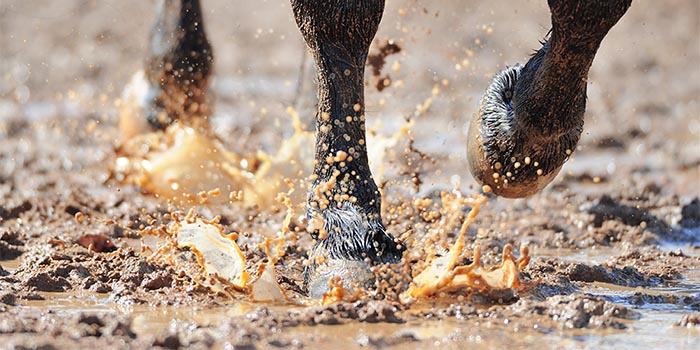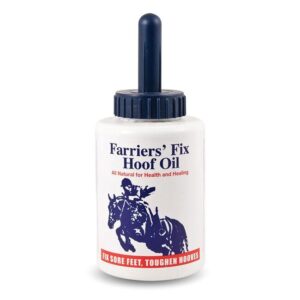
This past year, horse owners throughout the United States have experienced unprecedented weather conditions. With intense rain, floods, and extreme heat, many horse owners have struggled to maintain the integrity of their equine companions’ hooves. The severe weather has caused hooves everywhere to crumble and crack while increasing the likelihood of fungal infections, such as thrush.
We sat down with Rachel Richardson of Maple Hill Horseshoeing & Blacksmithing in Marlboro, VT, to get a farrier’s perspective on properly caring for and treating hooves in fluctuating weather.
The Cheshire Horse (CH): Starting out, can you give us some background regarding your experience as a farrier?

Rachel Richardson (RR): I graduated from the Montana State University Farrier School in 2015 and then apprenticed under a few expert farriers in North Carolina who worked primarily on sport horses. After that, I moved home and started my business in Vermont.
I am a Certified Farrier through the American Farrier’s Association (AFA) and on the Board of the Vermont Farrier Association, where I help bring continuing education clinicians to the state. I am currently working toward my AFA Certified Journeyman Farrier (CJF) credentials. Additionally, I do blacksmithing and metalwork on the side.
CH: What have been some of the challenges that you and your clients have been experiencing this year?
RR: Excess moisture has really been a problem this year, which has created some real issues for hooves. The continuous rain and flooding conditions mean the feet don’t get a chance to dry out, which can make them really soft and spongy.
When hooves are soft, they distort and change shape rapidly. These shape changes can have a negative effect on the integrity of the foot, and hooves tend to crumble. The crumbling hooves are especially prevalent when you add in the increasing workload that many horses endure during the summer months and when horses are standing around stomping at the flies.
This summer, we have also had some extreme heat and fluctuating temperatures. The heat and humidity have created an environment that is prime for fungus. I am seeing much more thrush and white line disease this year, which I am attributing to the weather conditions. The moist weather has also increased some fly populations, causing horses to stomp more and run more in the field.
CH: Environmentally, are there ways that equestrians can support their horse’s hooves?
RR: Absolutely. There are many ways that horse owners can promote excellent hoof health with their horse-keeping practices. I always advocate for keeping your horses’ paddocks and pastures as clean and dry as possible; I know this can be a struggle, but do your best!
Additionally, reduce the mud in high-traffic areas, such as by the hay feeder and water trough and pathways that horses frequently travel. Whether this means installing drainage, putting down gravel, or investing in one of the mud mats currently on the market, you will want to keep the areas where your horses spend time as dry as possible.
If you have access to a barn or a run-in shed, I highly encourage bringing your horses in during this wild weather to let their feet dry out. Standing on clean shavings in their stall can be highly beneficial when it is soggy outside in their paddocks.

You also want to make sure that you are picking and cleaning out their hooves on a regular basis. Use that hoof pick! Getting the mud and muck out of a mud-packed foot and letting it breathe is a simple yet effective way to cut down on the moisture in the hoof (I know, the last thing you want to do is grab onto a muddy hoof with your clean hands, but it’s really important!). Picking hooves is also a fantastic time to monitor the hoof wall, sole, and frog for signs of fungal activity, such as thrush and white line disease.
Finally, take a look at your fly control practices. Fly stomping takes a huge toll on hooves and can cause them to crack, crumble, pop clinches, and so much more. Fly boots can be an effective way to deter flies from landing on your horse’s legs. Fly repellents and fly sheets can really help, too! Some of my clients turn their horses out at night, when the flies are the least active, to reduce fly stomping to the best of their abilities.
CH: Are there any hoof care products that you recommend using during these times of extreme weather?
RR: I think that it is critical for people to stay on top of thrush and white line disease during this damp, humid weather. There are a number of high-quality anti-fungal products on the market, including Leovet FrogMedic Spray, Mustad Thrush Buster, and Equiderma Thrush & Whiteline Treatment.
When hooves are soft and damp, hoof hardening dressings can help to maintain the integrity of the hoof. I often recommend products like Mustad Tuff Stuff, Red Horse StrongHorn Hoof Hardener, and Keratex Hoof Hardener. If you want to go more of a natural route, I have found that the Pure Sole Hoof Mud is a fantastic product.
While I think that hoof conditioners have their place, especially in dry conditions, I have advised many of my clients to steer clear of them during wet periods, such as this summer. Their horses’ hooves are already very high in moisture, and the hoof conditioners compound the problem. If you feel like you absolutely need to use a hoof oil as part of your grooming practices, I recommend a dressing with antimicrobial properties, such as Farrier’s Fix Hoof Oil, Equine One Natural Hoof Dressing, Hawthorne Sole Pack Hoof Dressing, or Sport Horse Essentials Hoof Oil, because we are seeing so many bacterial and fungal issues with the heat, rain, and humidity.
CH: Is there anything else horse owners can do if they are worried about their horses’ hooves?
RR: Nutrition plays a huge role in hoof health, no matter what the weather is! I encourage many of my clients who are battling crumbling horns and weak hooves to consult with an equine nutritionist. A nutritionist can help you ensure that you are feeding your horse a balanced diet that has all of the nutrients that your horse needs to thrive.
Many of my clients have had great success by adding a hoof supplement and/or a vitamin E supplement to their horse’s daily rations. It’s important to remember that it will take nine months to a year for the hoof to grow out and for you to see the effects of the dietary changes, but it is well worth the time commitment!
CH: Many of us have struggled with our horse’s hooves crumbling to the point of losing shoes this summer. Is there anything that you can suggest?

RR: This has been a rough year for losing shoes! With popped clinches, crumbling walls, and nothing to nail the shoe to, it has been an enormous battle for keeping some horses’ shoes on, especially when this is a peak competition and riding season for my clients. I have succeeded by keeping horses with weak or degrading feet on a shorter shoeing cycle and staying ahead of problems. For example, if clients are typically on a six-week cycle, I may encourage a four-week cycle during this challenging weather.
Depending on your circumstances, it may be a great time to give your horses’ hooves a break and let them go barefoot. If you go this route, you may want to consider using hoof boots for added support and protection during riding or turnout sessions, especially if your horse is prone to abscesses or quarter cracks.
CH: Is there one takeaway you wished more horse owners understood about hoof health?
RR: That horse husbandry and the work they put in will make or break hoof health in the long run. Daily practices, like picking feet, maintaining a clean environment, and focusing on proper maintenance, will truly have the most significant effect on the hooves. Your farrier only comes once every four to six weeks. We do what we can when we are there, but we can only do so much. You and your farrier must work as a team for strong, healthy hooves and horses.
At The Cheshire Horse, we carry an extensive selection of hoof care supplies, including fungal treatments, hoof oils, hoof supplements, and more. If you have any questions about which products are the best for your horse’s hooves and their individual circumstances, we encourage you to reach out to a member of our friendly and highly-trained sales staff.


